Filling the Gap: AMOLED and LCD from 2010 to 2012
by Joshua Ho on July 26, 2014 6:00 AM EST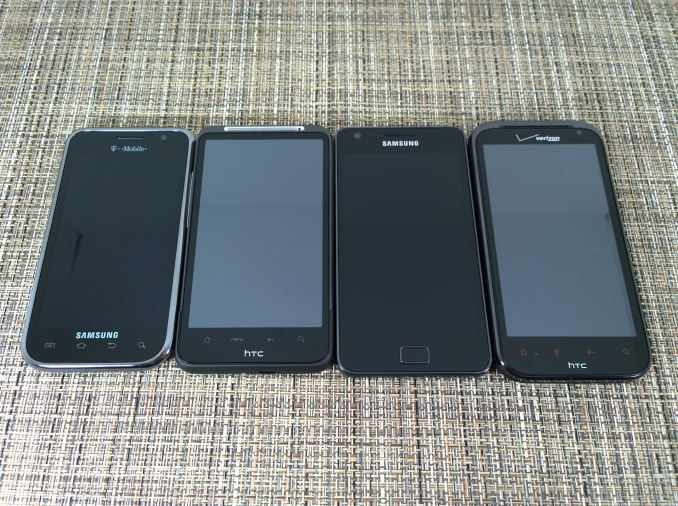
Introduction
For a while now, I’ve realized that there is a massive gap in the continuity of smartphone display history. Until the last few months of 2011 or early 2012, proper testing of smartphone displays was few and far between. Most websites tested peak brightness and contrast, and possibly white point. While some websites did go in depth, they would often only test a few phones. Of course, now things are different. Websites are starting to scrutinize display quality from all angles from color accuracy to reflectance, but no one has ever gone back to properly test old devices.
Of course, the best time to have tested these old devices was when they were new. The next best time is now, so let’s get to it. Unfortunately in the span of 4 years it’s become rather difficult to find all the devices that I’d like, but we’ll look at some of the key representative devices of each generation. This means the Galaxy S, Desire HD, Galaxy S2, and Rezound. The first three are all WVGA, 800x480 resolution displays. The Galaxy S has a 4 inch display, and all the other devices have a 4.3” display. All of them are also easily used with one hand, which is almost a surprise these days. Unfortunately, battery life testing won't be possible as all of the devices have aged too much for the results to be representative of their actual performance. As always, in order to properly test displays we use a custom workflow on SpectraCal's CalMAN 5.
Samsung Galaxy S
For most people, the Galaxy S would be their first encounter with Samsung’s SAMOLED displays and PenTile layouts. While it may have been acceptable at some point in the past, it’s quite obvious that this display hasn’t aged well at all. While high pixel density masks the effects of PenTile quite well, they’re omnipresent in the original Galaxy S. Even at relatively far distances from the display I can make out gaps between pixels in text. At the edges, there’s a strange effect where the lines are clearly not straight. Instead, the edges of text appear to be quite rough, making a zig zag pattern instead of a clean line.
Putting aside PenTile, the brightness of this display has aged relatively well. The expected brightness seems to be about 350 nits out of the box, and the T-Mobile unit I tested seemed to have lost some of its peak brightness, but it’s still quite bright at around 320 nits. Contrast is great as always here.
Grayscale is where things get ugly. Red is effectively no longer visible in the graph by 35% white, and both green and blue are completely out of control. The result is one of the worst averages for dE2000 error I’ve ever recorded.
In the saturation sweep, we see a similar story. Just about every type of mistake in color accuracy is seen here. Extreme blue/green shift on white, saturation compression, gamut far out of sRGB, hue shifts with saturation changes, and no way to improve it.
As expected, a similar result is seen in the Gretag Macbeth ColorChecker. This is simply a logical extension of poor color control in the saturations test, so this is no surprise. Looking at the Galaxy S5 LTE-A, it’s definitely incredible to see just how far Samsung has come since the early days of AMOLED technology.



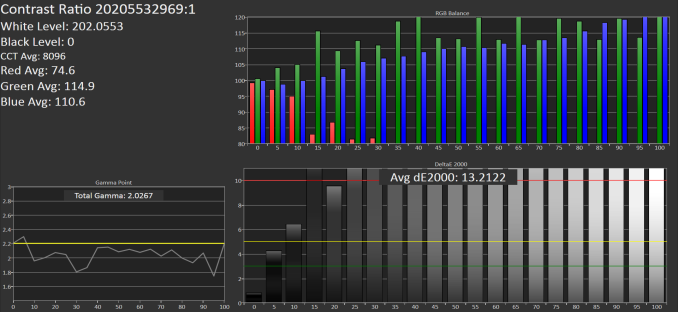
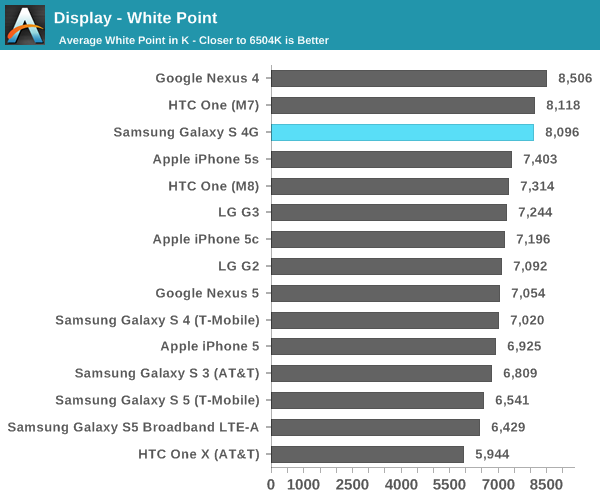
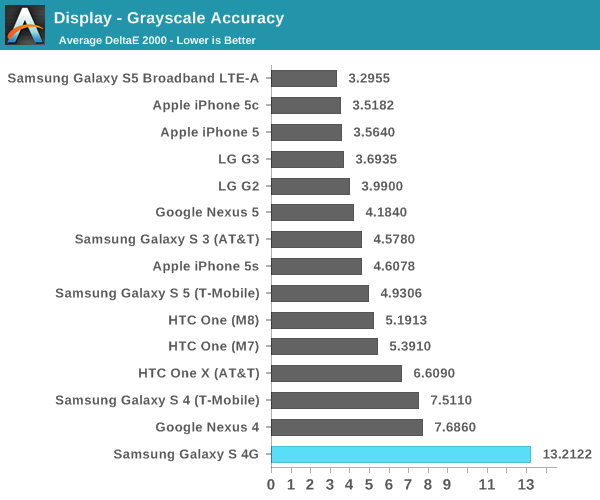

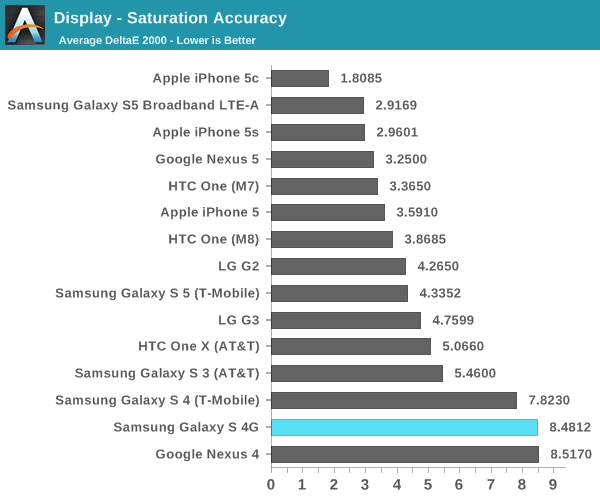
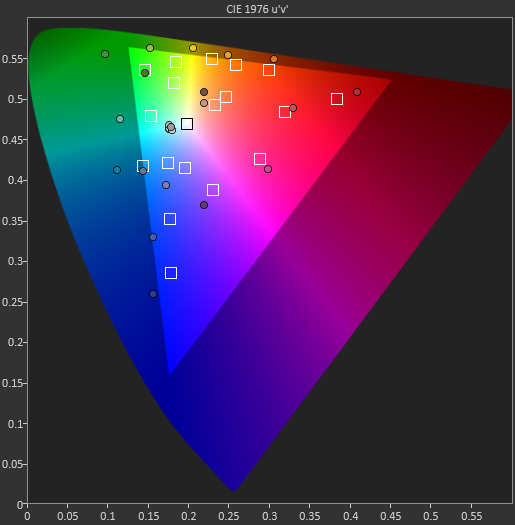
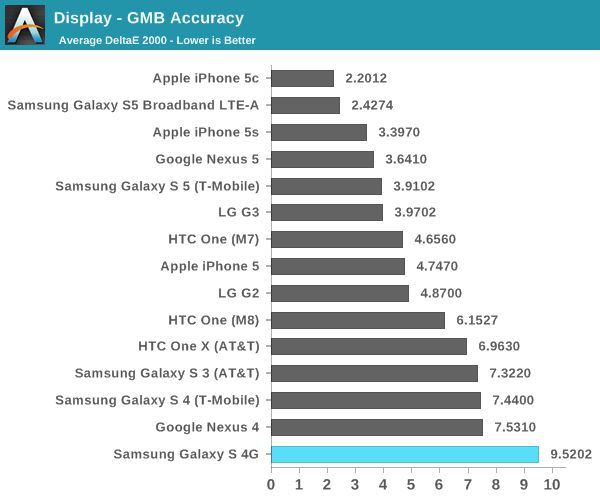








72 Comments
View All Comments
jabber - Sunday, July 27, 2014 - link
I beg your pardon? Please explain a little more?SentinelBorg - Monday, July 28, 2014 - link
Samsung phones since the S2 have different color modes you can choose from. The movie/video/cinema/whatever mode is usually the one closest to sRGB. No need to root it.plonk420 - Saturday, July 26, 2014 - link
still waiting for oLED monitors, considering SED is dead... : /extide - Tuesday, July 29, 2014 - link
What do you mean waiting for OLED? OLED has been around for a while, I mean.. this article...Alexey291 - Saturday, July 26, 2014 - link
I still find it funny that anand is trying so hard to push display accuracy.Except for the 3.5 anon-geeks commenting on this website nobody cares. People like pretty colours not "perfect colour accuracy" on a 4.3" (or even 5" - either way the size is tiny). Nobody ever ran the sammy displays in movie mode. Everyone who knows how - turns on Dynamic instantly because its simply prettier to look at.
But yeah rgb colours or whatever. They matter or something.
jwcalla - Saturday, July 26, 2014 - link
I agree that color accuracy is of no consequence to me (and probably most others) on a smartphone. I don't even necessarily consider it a positive benefit which is why I find these articles here somewhat mystifying.name99 - Saturday, July 26, 2014 - link
Accuracy matters if you use multiple devices in your life. For example it was very clear to me (and I'm not an artist or a color snob) that the contacts photos on my iPhone 1 looked different from the contacts photos on my iMac 2007. (Of course these were the same photos, being shared through iTunes.) It's not a big deal, but these are things you see every day, and it's irritating that the one you see seems redder than the other one you see.Obviously it's less of an issue for a movie you see once and never again, but it's something noticeable for things you see every day, and humans are probably more attuned to precise details of faces than anything else.
FWIW Apple seems to have got this right now (at least it's no longer so bad that I notice it every day even without trying). I assume that's a combination of newer HW (both the iMac and the iPhone have been upgraded) and perhaps some behind-the-scenes SW upgrades.
Alexey291 - Saturday, July 26, 2014 - link
I tend to (personally - so not implying that its the same for literally everyone) find that I generally get used to the worst screens given time.Aside from all my other gadgets (some of which have really good screens both amoled and IPS) I currently own a chromebook HP14 - yes the one with a godawful TN panel.
Honestly its been some months and these days I don't even notice. And I use the said chromebook a lot. But yeah its a case of YMMV for sure :)
Streamlined - Saturday, July 26, 2014 - link
It matters if you ever intend to print your camera photos. Imagine "fixing" a picture of the sunset to print the phot and it's either too saturated or to pale because your crappy phone was off base.JoshHo - Saturday, July 26, 2014 - link
For the most part, color calibration matters any time content is shared. For example, you could buy something that looks fine on your display, but the color is horrible in person. Similarly, with inaccurate displays you just don't know if other people will see the photo the way it appears on the phone.There is reason and logic behind display accuracy, and it certainly isn't a niche feature for a select few. There are use cases that apply to everyone. Samsung is probably doing the right thing by including a calibrated cinema/movie mode and the dynamic/standard modes depending upon personal preference.
I hope this helps with understanding why display accuracy matters.